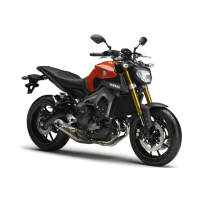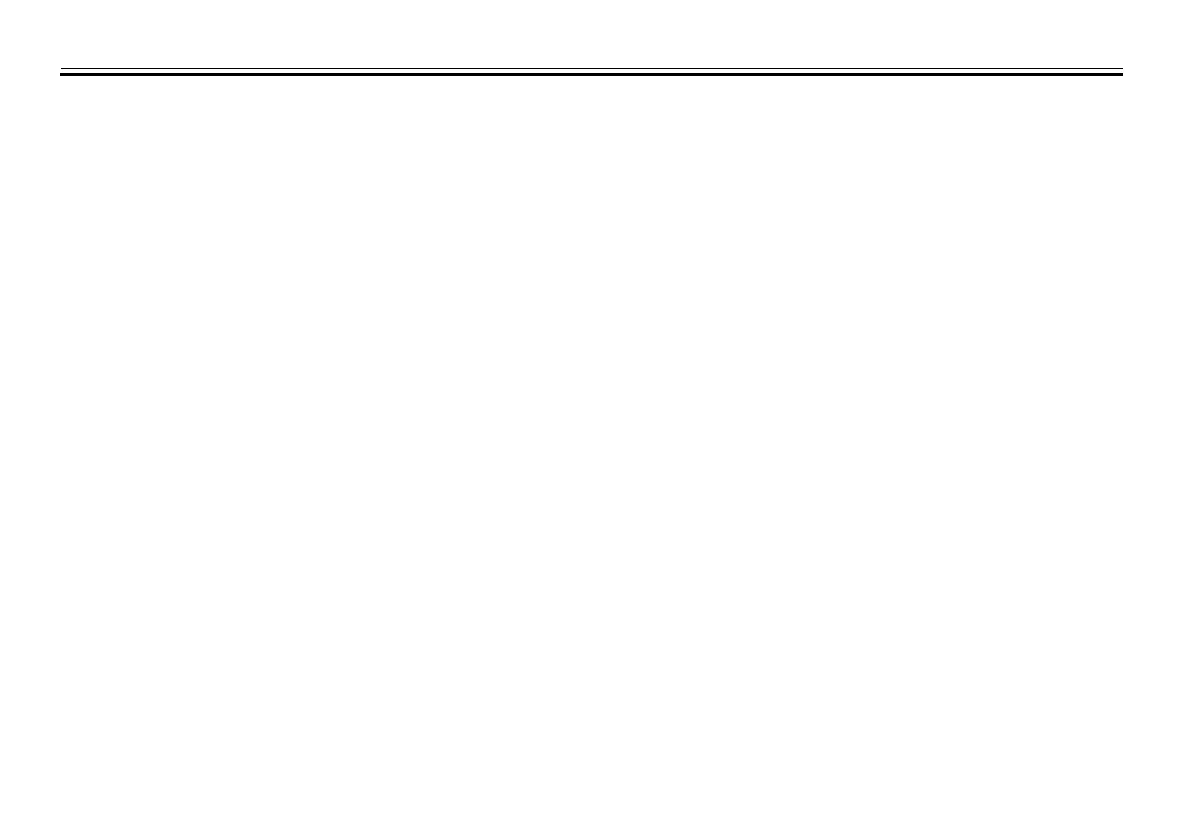
 Loading...
Loading...
Do you have a question about the Yamaha MT09 and is the answer not in the manual?
| Compression Ratio | 11.5:1 |
|---|---|
| Fuel System | Fuel Injection |
| Ignition System | TCI |
| Transmission | 6-speed |
| Final Drive | Chain |
| Engine Type | Liquid-cooled, 4-stroke, DOHC, 4-valve, inline 3-cylinder |
| Front Tire | 120/70ZR17 |
| Rear Tire | 180/55ZR17 |
| Overall Length | 2075mm |
| Overall Width | 815mm |
| Overall Height | 1120mm |
| Wheelbase | 1440mm |
| Wet Weight | 193kg |
| Fuel Capacity | 14L |
| Horsepower | 115 HP @ 10, 000 rpm |
| Torque | 87.5 Nm @ 8, 500 rpm |
| Front Suspension | Telescopic fork |
| Front Brakes | Hydraulic dual disc |
Owner's responsibilities for safe and proper operation of the motorcycle.
Guidelines for safe riding, pre-operation checks, and vehicle awareness.
Recommendations for protective clothing to prevent injury during accidents.
Precautions and dangers associated with carbon monoxide exposure from engine exhaust.
Identifies and labels components visible from the left side of the motorcycle.
Identifies and labels components visible from the right side of the motorcycle.
Illustrates and labels the various controls and instruments on the handlebars and dash.
Explains the motorcycle's anti-theft immobilizer system and its components.
Details the positions and functions of the main switch and steering lock.
Explains the meaning and function of various indicator and warning lights on the dashboard.
Describes the features and displays of the motorcycle's multi-function meter unit.
Explains the D-mode system for adjusting engine performance characteristics.
Identifies and explains the functions of various switches located on the handlebars.
Details the operation and function of the clutch lever.
Explains the operation and function of the motorcycle's shift pedal.
Describes the front brake lever, its adjustment, and operation.
Explains the operation and function of the rear brake pedal.
Explains the Anti-lock Brake System (ABS) features and operation for equipped models.
Details the Traction Control System (TCS) operation, settings, and indicators.
Instructions for opening and closing the fuel tank cap, with safety warnings.
Guidance on checking fuel level and safe refueling procedures, including fuel type.
Pre-operation check for fuel tank hoses to ensure proper function and prevent issues.
Information about the catalytic converter and safety precautions related to its heat.
Instructions on how to remove and install the motorcycle seat.
Location and use of the under-seat storage compartment, with load limits.
Instructions for adjusting front fork spring preload and rebound damping.
Guide to adjusting the rear shock absorber's spring preload and rebound damping.
Identifies the location of luggage strap holders on the passenger footrests.
Operation of the sidestand and its role in the ignition circuit cut-off system.
Explains the functions of the ignition circuit cut-off system involving switches.
Informs about the presence of an auxiliary DC connector for accessories.
Checks for fuel level, leaks, and condition of fuel tank hoses before operation.
Instructions for checking engine oil level and for oil leaks.
Procedures for checking coolant level and for coolant system leaks.
Checks front brake operation, pads, fluid level, and hydraulic system for leaks.
Checks rear brake operation, pads, fluid level, and hydraulic system for leaks.
Verifies clutch operation, cable lubrication, and lever free play.
Ensures smooth throttle operation and checks/adjusts free play.
Checks control cable operation and lubrication for smooth movement.
Checks drive chain slack, condition, and lubrication.
Inspects wheels and tires for damage, tread depth, and air pressure.
Verifies smooth operation of brake and shift pedals, and lubrication of pivots.
Checks smooth operation of brake and clutch levers, and lubrication of pivots.
Checks sidestand operation and lubrication.
Confirms tightening of all chassis nuts, bolts, and screws.
Verifies operation of all instruments, lights, signals, and switches.
Checks the sidestand switch operation as part of the ignition cut-off system.
Step-by-step guide to starting the motorcycle's engine safely and correctly.
Explains how to shift gears for acceleration, deceleration, and neutral.
Guidance on the initial break-in period for the engine to ensure longevity.
Instructions for safely parking the motorcycle and relevant warnings.
Locates and describes the contents of the owner's tool kit for minor repairs.
Schedule for maintenance tasks related to the vehicle's emission control system.
Comprehensive chart detailing general maintenance and lubrication intervals based on odometer readings.
Procedure for checking spark plug condition, gap, and replacement.
How to check, change engine oil, and replace the oil filter cartridge.
Instructions for checking coolant level and changing the coolant.
Information on replacing the air filter element at specified intervals.
How to check and adjust the engine idling speed.
How to measure and adjust the throttle grip's free play.
Explains the importance of valve clearance and dealer adjustment.
Guidance on tire condition, air pressure, and replacement for safety and performance.
Checks for wheel damage, bends, and the need for balancing after tire changes.
Instructions for adjusting the clutch lever's free play.
How to check for free play in the brake lever and potential issues.
Procedures for adjusting the rear brake light switch for proper activation.
How to check brake pad wear using indicators and when to replace them.
How to check and replenish brake fluid levels, with safety precautions.
Details on when to change brake fluid and replace related seals/hoses.
How to check and adjust the drive chain slack to proper specifications.
Proper methods for cleaning and lubricating the drive chain using specific lubricants.
Checking and lubricating all control cables for smooth operation and preventing damage.
Checking throttle grip operation and lubricating the cable and grip housing.
Checking pedal operation and lubricating pivot points for smooth movement.
Checking lever operation and lubricating pivot points for smooth action.
Checking sidestand operation and lubricating pivot and contact surfaces.
Instructions for lubricating the swingarm pivots at specified intervals.
How to check the condition and operation of the front fork.
Checking steering bearings for wear or looseness to ensure safe operation.
Checking wheel bearings for play or roughness for smooth wheel rotation.
Information about the VRLA battery, lead connections, and safety precautions.
Step-by-step guide to accessing and replacing fuses in fuse box 1.
Instructions for replacing a burnt-out halogen headlight bulb.
How to replace burnt-out bulbs in the auxiliary lights.
Information on the LED brake/tail light and what to do if it doesn't function.
Procedure for replacing a burnt-out turn signal light bulb.
How to replace the license plate light bulb if it burns out.
Methods for securely supporting the motorcycle for maintenance tasks.
Instructions for removing the front wheel on non-ABS models.
Instructions for removing the rear wheel on non-ABS models.
General advice on troubleshooting vehicle problems and seeking dealer assistance.
Charts to help diagnose common starting problems and poor engine performance.
Steps to take if the engine overheats, including safety warnings.
Precautions for cleaning and maintaining matte finish parts to avoid damage.
General advice on regular cleaning and maintenance for optimal performance and appearance.
Guidelines for short-term and long-term storage of the motorcycle to prevent damage.
Technical specifications related to the motorcycle's physical dimensions and curb weight.
Key engine specifications including combustion cycle, cooling, valve train, and displacement.
Details on recommended fuel, tank capacity, and spark plug specifications.
Specifications for tires including size, manufacturer, and type, plus wheel details.
Recommended tire air pressures for various load conditions.
Specifications for the front and rear suspension type, spring, and shock absorber.
Specifications for the electrical system, including voltage, ignition, and battery details.
Details wattage and quantity for all motorcycle bulbs and lists all fuses with amperage.
Where to find and record vehicle identification and engine serial numbers.
Locates the vehicle identification number stamped on the steering head pipe.
Locates the engine serial number stamped on the crankcase.
Location and purpose of the model label for ordering spare parts.